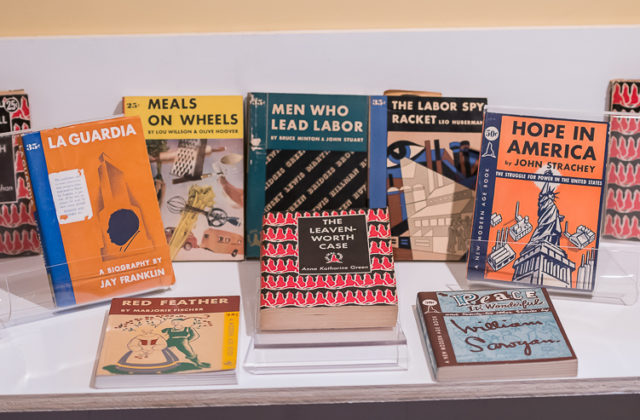The Paperback Revolution That Started in Norfolk
How Modern Age Books changed the way Americans read
By Lucy Mookerjee
Modern Age Books, Inc., founded by Norfolk’s Richard S. Childs in 1936, was the first large-scale publisher to produce paperback books in the United States. Modern Age released progressive paperbacks that were inexpensive and accessible to the general public. On display at the Norfolk Historical Museum on the weekend of October 13 and 14. Paperback Revolution will offer a quick glimpse of the innovative illustration, printing, and distribution techniques Childs used help democratize reading, writing, and publishing on the eve of World War II. Contemporary newspapers called Modern Age Books the “most interesting development in the history of publishing.”
Seizing on the increased interest in the mass marketing of paperbound books in Western Europe and Russia, Modern Age began to issue high-quality low-priced books in paper bindings in New York City. Paperback Revolution will feature some of the earliest books produced by Modern Age. The titles appear in lively pictorial dust wrappers. Beneath the wrappers, books have cover illustrations identical to their jackets – each designed to catch the eye, and to dramatize their contents. Retailing at 25 and 35 cents, these books enjoyed a first printing of 50,000 – 100,000 copies.
Modern Age positioned its books in drugstores, newsstands, and department stores. The publisher later added a book club to its list service. Not unlike its predecessor, Book of the Month Club, Modern Age books were selected by an editorial board and distributed to club members for a nominal fee. Book Club members were encouraged to nominate books, not already announced or available for reprinting, for special deluxe binding.
The biggest thorn in the side of the press was the question of maintaining distribution rates. Modern Age had entered the gates with shockingly high print runs. But by distributing the cost of composition, and ensuring accomplished presswork and good management, it was possible to keep the price of the “product” down. Paper bindings, moreover, were cheaper than cloth or board. Books were printed by nighttime union labor at the Rumford Press.
Original paperbacks were issued under the Red and Blue Seal imprints at 25 and 35 cents a copy; reprints (previously published books issued in new form) were available under the Gold Seal series of “good books” and were sold in both soft and hard cover, the latter being a division of Modern Age Books known as The Starling Press. Newspapers began to exclaim: “if the Modern Age experiment succeeds, it will usher in a new era in American publishing.” But with total profit margin of 10 cents a copy, the success of the company depended solely on an enormous volume of sales.
The concept of the paperback was not entirely new. In Western Europe – particularly in France – the idea had been passed along for years, and in the States, the firm Charles Boni began a paperback series, which produced 16 issues but was not able to sustain the Great Depression. Modern Age took advantage of Boni’s mistakes and began selling books at or below magazine prices. Determined to repackage reading “for-entertainment” as “books-for-the masses,” the press generated debate among the paper-versus-cloth publishing crowd. While some critics decried the high price of the slim volumes, a 1938 “Grievance Night” in Boston spurred discussion in which well-known authors expressed their concerns about the high cost of cloth books in America. A member of the Modern Age staff was able to quiet this “grievance” by explaining the goals of the Modern Age outfit.
Other “grievances” came in the specter of political figures. Mayor Fiorello LaGuardia recalled 50,000 copies of his biography (published October 1937), citing the book as libelous. Childs excised two sentences of the book and released it as planned, declaring, “in the interest of a free press we cannot accede to the mayor’s request.”
Spurred by the successes of its early years, Modern Age announced a new distribution plan in late 1938 in which foreign representatives of the company undertook the sales of books in Europe and the Orient. Soon after this venture, however, the Modern Age belief system was destroyed by its own model: in 1940, instead of selling five books at 25 cents apiece, the press was forced to sell off five books for a total of 49 cents. As such, it came as no surprise when, in October of 1942, Richard S. Childs announced “The Viking Press” had “taken over a large number of Modern Age’s books and author contracts.”
A socialist vision had once provided Modern Age Books with a revolutionary answer to an increasingly illiterate United States. Inevitably, obstacles arose. At the same time, a growing anxiety fueled fears that the firm had been taken over by Communists. By 1942, the editorial staff and directorship had all but disappeared, owing to the war effort, and Modern Age Books closed its doors.
Photo from the exhibit at the Norfolk Historical Society by Savage Frieze.

